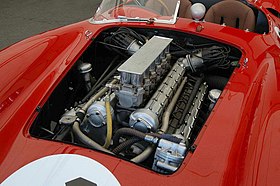 Jano V12 engine in Ferrari 412 S | |
| Overview | |
|---|---|
| Manufacturer | Ferrari |
| Production | 1956–1958 |
| Layout | |
| Configuration | 60° V12 |
| Displacement | 3.0 L (2,953 cc) 3.5 L (3,490 cc) 3.8 L (3,783 cc) 4.0 L (4,023 cc) |
| Cylinder bore | 73 mm (2.9 in) 76 mm (3.0 in) 77 mm (3.0 in) |
| Piston stroke | 58.8 mm (2.3 in) 69.5 mm (2.7 in) 72 mm (2.8 in) |
| Cylinder block material | Aluminium |
| Cylinder head material | Aluminium |
| Valvetrain | SOHC, 24-valve DOHC, 24-valve |
| Compression ratio | 9.0:1 - 9.9:1 |
| Combustion | |
| Fuel system | Weber carburetor |
| Fuel type | Petrol |
| Oil system | Dry sump |
| Cooling system | Water cooled |
| Chronology | |
| Predecessor | Ferrari Lampredi engine |
| Successor | Ferrari Colombo engine |
Vittorio Jano designed a new 60° V12 engine for sports car racing for Ferrari. This new engine, introduced in 1956, combined elements of both Colombo and Lampredi engines with new features.[1] Engine architecture was more of Lampredi school but retained smaller Colombo internal measurements. Jano moved to Ferrari along with his designs for the Lancia D50 in 1955 and went on to design not only a new V12 but also a family of the Dino V6 engines soon after.[2] Some of the technical ideas came from the Jano's Lancia V8 DOHC engine, intended for Formula One. This family of engines replaced Lampredi inline-4s known from Ferrari Monza line and went on to win many international races and titles for Ferrari.[3] The design team comprised Jano as well as Vittorio Bellentani,[4] Alberto Massimino (best known for the Maserati 250F), and Andrea Fraschetti.

All Jano engines used dry sump lubrication and almost all of them had two spark plugs per cylinder with four coils. Also most of them had DOHC configuration with chain-driven camshafts and two valves per cylinder.[5]
- ^ "Ferrari 290 MM". supercars.net. Retrieved 3 July 2019.
- ^ Schlegelmilch, Rainer W. (2004). Ferrari. Könemann. pp. 84–89.
- ^ "Driven by the Greats: 1956 Ferrari 290 MM Leads RM Sotheby's Los Angeles Auction". conceptcarz.com. Retrieved 3 July 2019.
- ^ Profiting from History Archived 29 September 2007 at the Wayback Machine quotes Phil Hill referring to the Jano V12 as the "Bellentani engine".
- ^ "Ferrari 290 MM". auto.howstuffworks.com. Retrieved 3 July 2019.